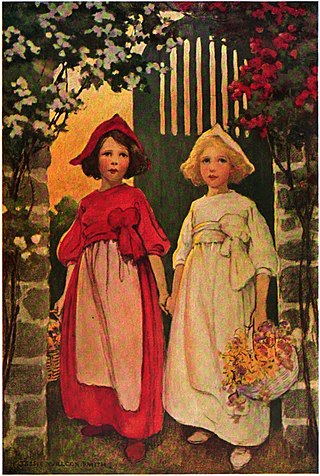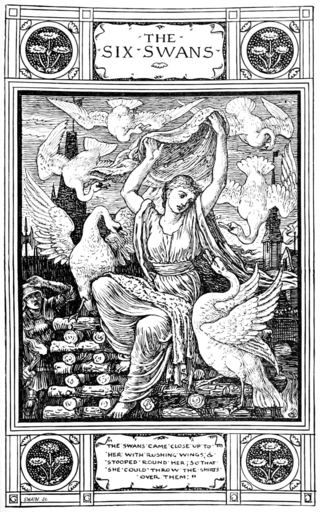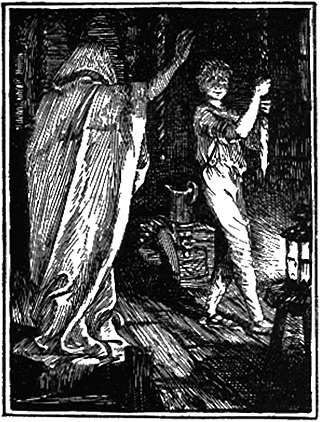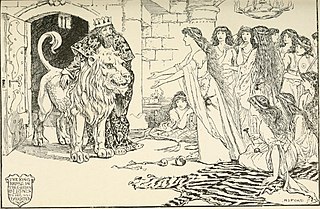Snow-White-Fire-Red (Bianca-comu-nivi-russa-comu-focu) is a Sicilian fairy tale collected by Giuseppe Pitre [1] and translated by Thomas Frederick Crane in Italian Popular Tales. [2]
A king and queen made a vow that, if they had a child, they would make one fountain run with oil and another with wine. The queen gave birth to a son, and they set up the fountains so that everyone could take oil and wine. At the end of the seven years, the fountains were running dry, and an ogress came to take the last with a sponge and pitcher. Once she had labored to collect it all, the prince threw a ball, breaking the pitcher. She cursed him to be unable to marry until he found Snow-White-Fire-Red.
When he grew up, he remembered this and set out. One night he slept in a great plain where there was a large house. In the morning, he saw an ogress come and call to Snow-White-Fire-Red to let down her hair. When the ogress left, he called to her, and she, thinking it was her mother (as she called the ogress), let down her hair. He climbed it and told her his tale. She told him the ogress would eat him, and so she hid him and asked the ogress how she could escape, if she wanted to. The ogress told her that she would have to enchant all the furniture to answer in her own voice, but that ogress would climb and find out in time, and so she would have to take seven balls of yarn and throw them down as the ogress caught up.
Snow-White-Fire-Red enchanted all the furniture, took the yarn, and fled with the prince. The ogress called to the furniture, and it answered until finally she climbed and discovered that the girl was gone. She chased after, calling to Snow-White-Fire-Red to turn around, which would have let her enchant her. Snow-White-Fire-Red threw down the yarn, and each ball impeded and injured her until she cursed the prince to forget Snow-White-Fire-Red as soon as his mother kissed him, and the ogress died.
The lovers went on, and the prince told Snow-White-Fire-Red that he would get her suitable clothing to appear at court. He forbade his mother to kiss him, but she came into his bedroom at night and kissed him while he slept, and he forgot Snow-White-Fire-Red.
An old woman took pity on Snow-White-Fire-Red and took her home. Snow-White-Fire-Red made marvelous things, and the old woman sold them. One day she told the old woman to get her scraps of cloth from the palace, and she dressed two doves that the old woman owned. The two birds flew to the palace, where everyone admired them, and the doves told the story of how the prince had won Snow-White-Fire-Red. He remembered and ordered the birds to be followed, and soon he and Snow-White-Fire-Red were married.
The tale was also translated as Snow White, Flaming Red and as Snow White, Blazing Red by Jack Zipes and Joseph Russo. [3] [4]
The tale is classified in the Aarne-Thompson-Uther Index as tale type ATU 310, "The Maiden in the Tower". [5]
Folklorist Thomas Frederick Crane noted that the tale also involved the motif of the magical escape from the maiden's ogre mother, a narrative sequence that appears in tale type ATU 313, "The Magic Flight". He also remarked that this Sicilian tale had the motif of "The Forgotten Fiancé": after the hero and his bride return to his home, he kisses someone and forgets about her and his adventures. [6]
Scholars Christine Goldberg and Max Lüthi indicated that Southern European variants of type ATU 310, "The Maiden in the Tower", show the episode of the Forgotten Fiancé, [7] for example, in Greek variants. [8]
According to Walter Puchner, in The Forgotten Fiancée subtype, it is "particularly common" in Mediterranean variants for the heroine to release doves to the prince's palace to remind him. This motif also occurs in combination with tale type ATU 310 in Mediterranean tales. [9]

"Snow White" is a German fairy tale, first written down in the early 19th century. The Brothers Grimm published it in 1812 in the first edition of their collection Grimms' Fairy Tales, numbered as Tale 53. The original German title was Sneewittchen; the modern spelling is Schneewittchen. The Grimms completed their final revision of the story in 1854, which can be found in the 1857 version of Grimms' Fairy Tales.

"Snow-White and Rose-Red" is a German fairy tale. The best-known version is the one collected by the Brothers Grimm in 1837 in the third edition of their collection Grimm's Fairy Tales. It was first published by Wilhelm Grimm in 1827 in Wilhelm Hauff's Märchen-Almanach. An older, somewhat shorter version, "The Ungrateful Dwarf", was written by Caroline Stahl (1776–1837). Indeed, that appears to be the oldest variant; no previous oral version is known, although several have been collected since its publication in 1818. Oral versions are very limited regionally. The tale is of Aarne-Thompson type 426.

"The Six Swans" is a German fairy tale collected by the Brothers Grimm in Grimm's Fairy Tales in 1812. It is of Aarne–Thompson type 451, commonly found throughout Europe. Other tales of this type include The Seven Ravens, The Twelve Wild Ducks, Udea and her Seven Brothers, The Wild Swans, and The Twelve Brothers. Andrew Lang included a variant of the tale in The Yellow Fairy Book.

"The Story of the Youth Who Went Forth to Learn What Fear Was" or "The Story of a Boy Who Went Forth to Learn Fear" is a German folktale collected by the Brothers Grimm in Grimm's Fairy Tales. The tale was also included by Andrew Lang in The Blue Fairy Book (1889).

"The Master Maid" is a Norwegian fairy tale collected by Peter Christen Asbjørnsen and Jørgen Moe in their Norske Folkeeventyr. "Master" indicates "superior, skilled." Jørgen Moe wrote the tale down from the storyteller Anne Godlid in Seljord on a short visit in the autumn of 1842. Andrew Lang translated the tale to English and included it in his The Blue Fairy Book (1889). A later translation was made by George Dasent, in his Popular Tales from the North.
How the Devil Married Three Sisters is an Italian fairy tale found in Thomas Frederick Crane's Italian Popular Tales (1885). It was collected and originally published in German as "Der Teufel heirathet drei Schwestern" by Widter and Wolf in 1866.
"Thirteenth" is an Italian fairy tale originally collected by Sicilian folklorist Giuseppe Pitrè and published by Thomas Frederick Crane in Italian Popular Tales. It is Aarne-Thompson type 328, "The Boy Steals the Giant's Treasures".

The Battle of the Birds is a Scottish fairy tale collected by John Francis Campbell in his Popular Tales of the West Highlands. He recorded it in 1859 from a fisherman near Inverary, John Mackenzie and was, at the time, building dykes on the Ardkinglas estate.
Gold-Tree and Silver-Tree is a Scottish fairy tale collected by Joseph Jacobs in his Celtic Fairy Tales. It is Aarne-Thompson type 709, Snow White. Others of this type include Bella Venezia, Nourie Hadig, La petite Toute-Belle and Myrsina.
The Enchanted Wreath is a Scandinavian fairy tale, collected in Benjamin Thorpe in his Yule-Tide Stories: A Collection of Scandinavian and North German Popular Tales and Traditions. Andrew Lang adapted a variant of it for The Orange Fairy Book.

The Golden Lion is an Italian fairy tale collected by Laura Gonzenbach in Sicilianische Märchen. Andrew Lang included it in The Pink Fairy Book.

The Bee and the Orange Tree is a French literary fairy tale by Madame d'Aulnoy.
Anthousa, Xanthousa, Chrisomalousa or Anthousa the Fair with Golden Hair is a Greek fairy tale collected by Greek folklorist Georgios A. Megas in Folktales of Greece. Other variants were collected by Michalis Meraklis and Anna Angelopoulou.
The King of Love is an Italian fairy tale from Sicily collected by Giuseppe Pitre and translated into English by Thomas Frederick Crane in Italian Popular Tales.
The Young Slave is an Italian literary fairy tale written by Giambattista Basile in his 1634 work, the Pentamerone.
Maroula is a Greek fairy tale collected by Georgios A. Megas in Folktales of Greece.
The Dove is an Italian literary fairy tale written by Giambattista Basile in his 1634 work, the Pentamerone.
Prâslea the Brave and the Golden Apples is a Romanian fairy tale collected by Petre Ispirescu in Legende sau basmele românilor.
In folkloristics, "The Animal as Bridegroom" refers to a group of folk and fairy tales about a human woman marrying or being betrothed to an animal. The animal is revealed to be a human prince in disguise or under a curse. Most of these tales are grouped in the international system of Aarne-Thompson-Uther Index under type ATU 425, "The Search for the Lost Husband". Some subtypes exist in the international classification as independent stories, but they sometimes do not adhere to a fixed typing.
The Golden Root or The Golden Trunk is a literary fairy tale written by Giambattista Basile in the Pentamerone, as the fourth story of the fifth day. It is considered to be one of two rewritings of the Graeco-Roman myth of "Cupid and Psyche" by Basile, the other being "Lo Catenaccio".